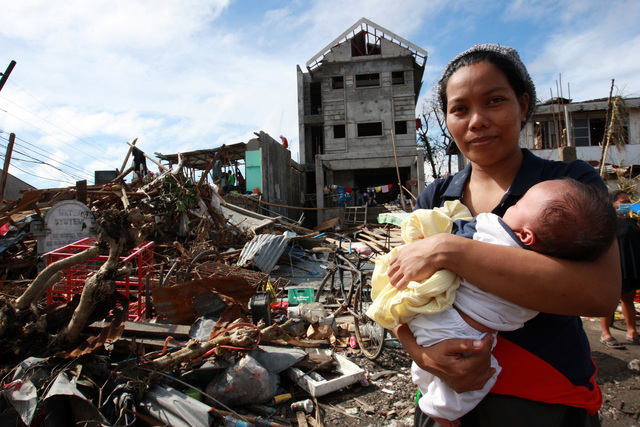Children will bear the brunt of climate change: UNICEF
2015-11-24

© UNICEF/NYHQ2013-1027/Maitem
A woman and her baby amid deis and other destruction caused by Super Typhoon Haiyan in the Philippines.
More than half a billion children live in areas with extremely high flood occurrence, 160 million live in high drought severity areas
NEW YORK/GENEVA/ HONG KONG, 24 November 2015 – More than half a billion children live in areas with extremely high flood occurrence and 160 million in high drought severity zones, leaving them highly exposed to the impacts of climate change, UNICEF said in a report released ahead of the 21st United Nations climate change conference, known as COP21.
Of the 530 million children in the flood-prone zones, some 300 million live in countries where more than half the population lives in poverty – on less than HK$24.2 (US$3.10) a day. Of those living in high drought severity areas, 50 million are in countries where more than half the population lives in poverty.
“The sheer numbers underline the urgency of acting now,” said UNICEF Executive Director Anthony Lake. “Today’s children are the least responsible for climate change, but they, and their children, are the ones who will live with its consequences. And, as is so often the case, disadvantaged communities face the gravest threat.”
Climate change means more droughts, floods, heatwaves and other severe weather conditions. These events can cause death and devastation, and can also contribute to the increased spread of major killers of children, such as malnutrition, malaria and diarrhoea. This can create a vicious circle: A child deprived of adequate water and sanitation before a crisis will be more affected by a flood, drought, or severe storm, less likely to recover quickly, and at even greater risk when faced with a subsequent crisis.
The vast majority of the children living in areas at extremely high risk of floods are in Asia, and the majority of those in areas at risk of drought are in Africa.
World leaders gathering in Paris for COP21 – held from November 30 to December 11 – will seek to reach agreement on cutting greenhouse gas emissions, which most experts say is critical to limiting potentially catastrophic rises in temperature.
“We know what has to be done to prevent the devastation climate change can inflict. Failing to act would be unconscionable,” said Lake. “We owe it to our children – and to the planet – to make the right decisions at COP21.”
| Donate now to support UNICEF’s programmes worldwide |









